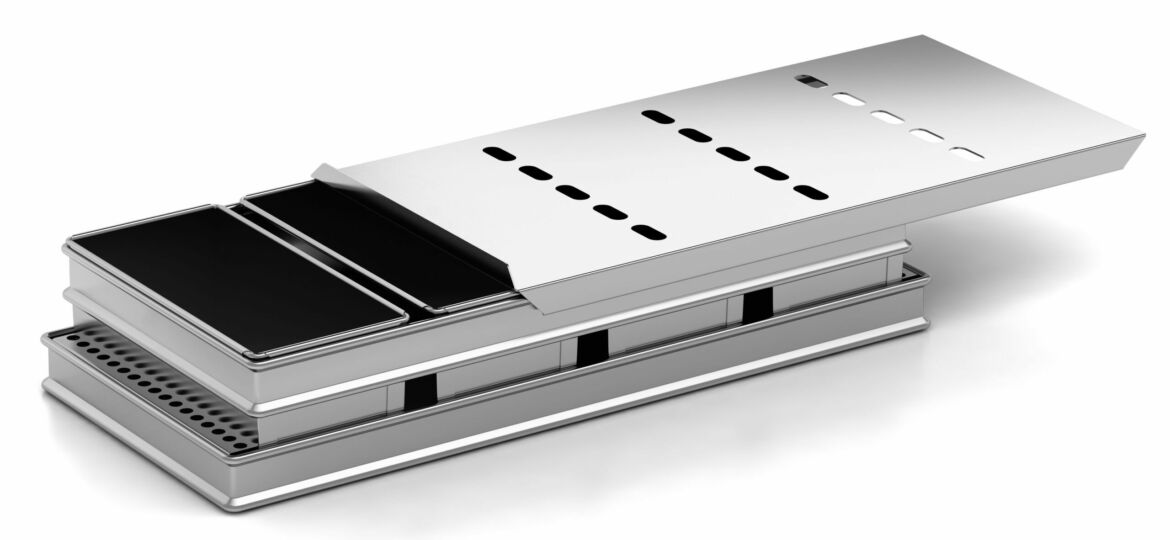
Trays come in shapes and sizes as diverse as the products that they will help to make, while also considering the equipment and handling methods in each bakery. A characteristic they all have in common, regardless of endless possibilities in their layouts, is the safety guarantee provided for the products baked, time and again.
Trays are provided in the exact design needed to be the best fit for all bakery specialties and can differ in sizes, slide and stack accessories, thickness and coatings, to meet manufacturing requirements. Anneliese has automated the production of standard trays and is channeling its R&D resources towards large-scale customizations. “We are specialized in customizing in big quantities, from flat trays to customized mold trays for croissants or baguettes and different types of special shapes. From 580-780mm up to 2,000-800mm, we manufacture industrial trays in any size,” Dennis Wendlinger, Anneliese CEO, highlights. Since no two bakeries are alike, the same is true for their requirements regarding baking trays, pans, coatings and any related accessories. Anneliese makes use of its in-house tooling department and team of product designers to develop a solution for every request. “We cover virtually everything, from robot handles to stacking bolts, to changeable inlets, to special mold designs,” he illustrates. Anneliese also observes a growing trend for the use of plastic peelboards in industrial baking.

Industrial baking: safety is everything
Upgrading bakeware will amount to significant improvements in their utilization on industrial lines; in addition, when they are correctly utilized and maintenance is performed, the results become easily visible. For high-volume manufacturing setups, which imply a high degree of automatization, high-quality coatings and timely recoating are a must, to ensure the maximum uptime (and eventually, lifespan) of the trays. The best choice for a coating comes from a good connection with the customer, in Anneliese’s experience. It requires having detailed information about the product, the line, the bakery environment, the dough, the humidity, among others. “A good coating will ensure products do not stick to the tray or tin, resulting in better product quality, a safe process using non-sticking agents or oils, safe cleaning, and value for money as a result,” Anneliese outlines.
Care for coatings
The approach to the product’s safety, as well as hygiene, depends on the tray. The presence and type of coating play a big role in this. Anneliese highly recommends working with coatings in industrial baking, where they contribute to obtaining high-quality products and ensure the utmost hygiene while also being mindful of the environment in the process as no release agents are needed. By and large, it is a combination that amounts to earning ‘safe money’. Coatings come highly specialized to closely match the baking requirements of each type of product, from those designed specifically for buns and craft bakery goods to more ‘extreme’ applications such as those required by automatic tin-set lines or sourdough products. Factors that are frequently behind coating damage start with using the wrong coating for the wrong product: “Not every coating is made for lye products, for example,” Dennis Wendlinger illustrates. Then, inadequate cleaning, baking, depanning, handling and storing are the usual suspects. The optimum coating will depend on material, dough and process. To help maximize the efficiency in repeated production cycles and extend the lifetime of both coating and tray or tin set, Anneliese provides utilization guidelines fitting each production environment. For general considerations on how to preserve coatings, empty trays should not be stored in heated ovens, which can heavily compromise the lifetime of anti-stick properties; they should also be thoroughly dried before usage, as water residue will help products adhere to surfaces, which is harmful to the coating. Correct washing and drying is half the battle in maximizing lifespan, to ensure they are ready for reuse as quickly as possible without damaging surfaces. Anneliese bakeware should only be cleaned with water and a commercially available neutral cleaning agent (pH 7), with a soft jet of water and/or soft cleaning brushes. The company advises against plunging or using high pressure to clean trays or tins.
The bottom line is that coated bakeware should not be used until the point when oil or release agents have to be used – because this is not economical in the long term. Anneliese’s advice: “Inform your employees or colleagues about the coating and ask them to report back if it starts losing its non-stick effect. You will receive advice as to whether your bakeware is ready for recoating or you need to invest in new bakeware.”
As for the choice of trays for industrial bakeries, the company recommends bakeware with perforated sheets riveted on stainless steel tubes, with no edges – when the products and the production line allow it. Alternatively, smaller options have stainless steel tube frames and are bent on two sides without creating ‘dirt collecting edges’. “This also depends on the line and the bakery. The two-, three-, four-edged or rimmed trays are almost exclusively seen outside of the industrial field, in small and medium-sized bakeries,” Wendlinger observes.

The article is part of an extended feature, which was originally published in [BBI 5 – 2021]. Read the full article in the magazine:


